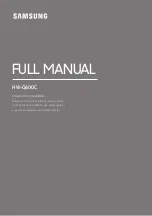
300ACDC
3
INSTALLATION
3 – 3
6
High Frequency Introduc-
tion
The importance of correct installation of high fre-
quency welding equipment cannot be over-empha-
sized. Interference due to high frequency initiated
or stabilized arc is almost invariably traced to
improper installation. The following information is
intended as a guide for personnel installing high
frequency welding machines.
WARNING: Explosives
The high frequency section of this machine has an
output similar to a radio transmitter. The machine
should NOT be used in the vicinity of blasting oper-
ations due to the danger of premature firing.
WARNING: Computers
It is also possible that operation close to computer
installations may cause computer malfunction.
7
High Frequency Interfer-
ence
Interference may be transmitted by a high fre-
quency initiated or stabilized arc welding machine
in the following ways:
1.
Direct Radiation:
Radiation from the machine
can occur if the case is metal and is not prop-
erly grounded. It can occur through apertures
such as open access panels. The shielding of
the high frequency unit in the Power Source
will prevent direct radiation if the equipment is
properly grounded.
2.
Transmission via the Supply Lead:
Without
adequate shielding and filtering, high fre-
quency energy may be fed to the wiring within
the installation (mains) by direct coupling. The
energy is then transmitted by both radiation
and conduction. Adequate shielding and filter-
ing is provided in the Power Source.
3.
Radiation from Welding Leads:
Radiated
interference from welding leads, although pro-
nounced in the vicinity of the leads, diminishes
rapidly with distance. Keeping leads as short
as possible will minimize this type of interfer-
ence. Looping and suspending of leads
should be avoided where possible.
4.
Re-radiation from Unearthed Metallic
Objects:
A major factor contributing to interfer-
ence is re-radiation from unearthed metallic
objects close to the welding leads. Effective
grounding of such objects will prevent re-radia-
tion in most cases.
8
Duty Cycle
The duty cycle of a welding power source is the
percentage of a ten (10) minute period that it can
be operated at a given output without causing over-
heating and damage to the unit. If the welding
amperes decrease, the duty cycle increases. If the
welding amperes are increased beyond the rated
output, the duty cycle will decrease.
WARNING
Exceeding the duty cycle ratings will cause the
thermal overload protection circuit to become ener-
gized and shut down the output until the unit has
cooled to normal operating temperature.
CAUTION
Continually exceeding the duty cycle ratings can
cause damage to the welding power source and
will void the manufactures warranty.
NOTE
Due to variations that can occur in manufactured
products, claimed performance, voltages, ratings,
all capacities, measurements, dimensions and
weights quoted are approximate only. Achievable
capacities and ratings in use and operation will
depend upon correct installation, use, applications,
maintenance and service.
Summary of Contents for ARCMASTER 300 AC/DC
Page 2: ......
Page 31: ...300ACDC 5 SET UP FOR SMAW STICK AND GTAW TIG 5 2 PAGE LEFT INTENTIONALLY BLANK ...
Page 35: ...300ACDC 7 ROUTINE MAINTENANCE 7 2 PAGE LEFT INTENTIONALLY BLANK ...
Page 41: ...300ACDC 8 BASIC TROUBLESHOOTING 8 6 PAGE LEFT INTENTIONALLY BLANK ...
Page 109: ...THIS PAGE LEFT INTENTIONALLY BLANK ...
Page 113: ......
















































